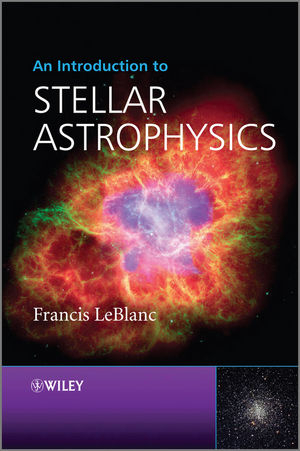
An Introduction to Stellar Astrophysics
John Wiley & Sons Inc (Verlag)
978-0-470-69956-0 (ISBN)
An Introduction to Stellar Astrophysics aspires to provide the reader with an intermediate knowledge on stars whilst focusing mostly on the explanation of the functioning of stars by using basic physical concepts and observational results. The book is divided into seven chapters, featuring both core and optional content:
Basic concepts
Stellar Formation
Radiative Transfer in Stars
Stellar Atmospheres
Stellar Interiors
Nucleosynthesis and Stellar Evolution and
Chemically Peculiar Stars and Diffusion.
Student-friendly features include:
Detailed examples to help the reader better grasp the most important concepts
A list of exercises is given at the end of each chapter and answers to a selection of these are presented.
Brief recalls of the most important physical concepts needed to properly understand stars.
A summary for each chapter
Optional and advanced sections are included which may be skipped without interfering with the flow of the core content.
This book is designed to cover the most important aspects of stellar astrophysics inside a one semester (or half-year) course and as such is relevant for advanced undergraduate students following a first course on stellar astrophysics, in physics or astronomy programs. It will also serve as a basic reference for a full-year course as well as for researchers working in related fields.
Francis LeBlanc is a professor in the Department of Physics and Astronomy of Université de Moncton (Canada). He was educated at the Université de Moncton and then went on to obtain a Masters degree and a PhD from the Université de Montréal (Canada). During these graduate studies, he was awarded prestigious graduate studies scholarships from the Natural Sciences and Engineering Research Council of Canada (NSERC), as well as other scholarships. In 1994, he was hired as assistant professor at the Department of Physics and Astronomy at the Université de Moncton, then promoted to associate professor and finally was promoted to full professor in January 2008. Professor LeBlanc has been an active researcher and has obtained research grants from the NSERC. His fields of expertise are diffusion in stars, chemically peculiar stars and stellar atmospheres. Professor LeBlanc is responsible for the university's observatory, has taught several undergraduate courses on general astronomy, astrophysics and space sciences, modern physics and introduction to nuclear physics and a graduate course on stellar astrophysics.
Preface. Acknowledgments.
Chapter 1: Basics Concepts.
1.1 Introduction.
1.2 The Electromagnetic Spectrum.
1.3 Blackbody Radiation.
1.4 Luminosity, Effective Temperature, Flux and Magnitudes.
1.5 Boltzmann and Saha Equations.
1.6 Spectral Classification of Stars.
1.7 The Hertzsprung-Russell Diagram.
Chapter 2: Stellar Formation.
2.1 Introduction.
2.2 Hydrostatic Equilibrium.
2.3 The Virial Theorem.
2.4 The Jeans Criteria.
2.5 Free-Fall Times† .
2.6 Pre-Main-Sequence Evolution† .
Chapter 3: Radiative Transfer in Stars.
3.1 Introduction.
3.2 Radiative Opacities.
3.3 Specific Intensity and Radiative Moments.
3.4 Radiative Transfer Equation.
3.5 Local Thermodynamic Equilibrium.
3.6 Solution of the Radiative Transfer Equation.
3.7 Radiative Equilibrium.
3.8 Radiative Transfer at Large Optical Depths.
3.9 Rosseland and Other Mean Opacities.
3.10 Schwarzschild-Milne Equations†† .
3.11 Demonstration of the Radiative Transfer Equation† .
3.12 Radiative Acceleration of Matter And Radiative Pressure† .
Chapter 4: Stellar Atmospheres.
4.1 Introduction.
4.2 The Grey Atmosphere.
4.3 Line Opacities and Broadening.
4.4 Equivalent Width and Formation Of Atomic Lines.
4.5 Atmospheric Modelling.
Chapter 5: Stellar Interiors.
5.1 Introduction.
5.2 Equations of Stellar Structure.
5.3 Energy Transport in Stars.
5.4 Polytropic Models.
5.5 Structure of The Sun.
5.6 Equation of State.
5.7 Variable Stars and Asteroseismology.
Chapter 6: Nucleosynthesis and Stellar Evolution.
6.1 Introduction.
6.2 Generalities Concerning Nuclear Fusion.
6.3 Models of the Nucleus† .
6.4 Basic Physics of Nuclear Fusion.
6.5 Main-Sequence Burning.
6.6 Helium Burning Phase.
6.7 Advanced Nuclear Burning.
6.8 Evolutionary Tracks in the H.-R. Diagram.
6.9 Stellar Clusters.
6.10 Stellar Remnants.
6.11 Novae and Supernovae† .
6.12 Heavy Element Nucleosynthesis: s, r and p Processes† .
6.13 Nuclear Reaction Cross-Sections and Rates†† .
Chapter 7: Chemically Peculiar Stars and Diffusion†.
7.1 Introduction and Historical Background.
7.2 Chemically Peculiar Stars.
7.3 Diffusion Theory†† .
7.4 Radiative Accelerations†† .
7.5 Other Transport Processes†† .
Answers to Selected Exercises.
Appendix A: Physical Constants.
Appendix B: Units in the cgs. and SI Systems.
Appendix C: Astronomical Constants.
Appendix D: Ionization Energies (in eV) for the First Five Stages of Ionization for the Most Important Elements.
Appendix E: Solar Abundances for the Most Important Elements.
Appendix F: Atomic Masses.
Appendix G: Physical Parameters for Main-Sequence Stars.
Appendix H: Periodic Table of the Elements.
References.
Bibliography.
Index.
| Erscheint lt. Verlag | 17.5.2010 |
|---|---|
| Verlagsort | New York |
| Sprache | englisch |
| Maße | 169 x 245 mm |
| Gewicht | 626 g |
| Themenwelt | Naturwissenschaften ► Physik / Astronomie ► Astronomie / Astrophysik |
| ISBN-10 | 0-470-69956-6 / 0470699566 |
| ISBN-13 | 978-0-470-69956-0 / 9780470699560 |
| Zustand | Neuware |
| Haben Sie eine Frage zum Produkt? |
aus dem Bereich


